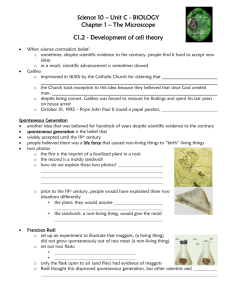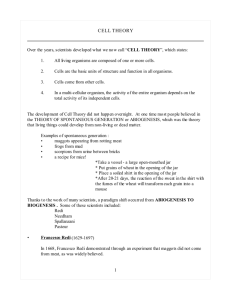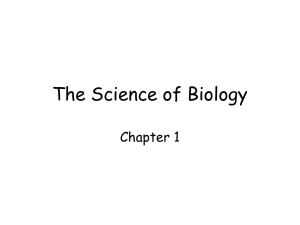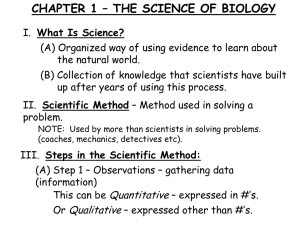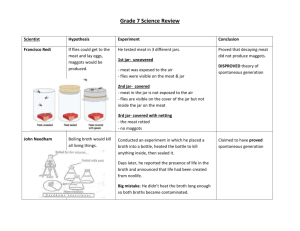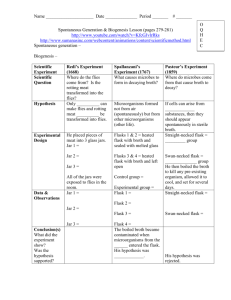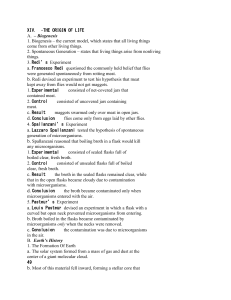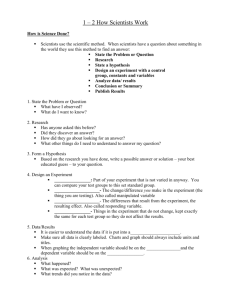Chapter 14* Origin of Life
advertisement
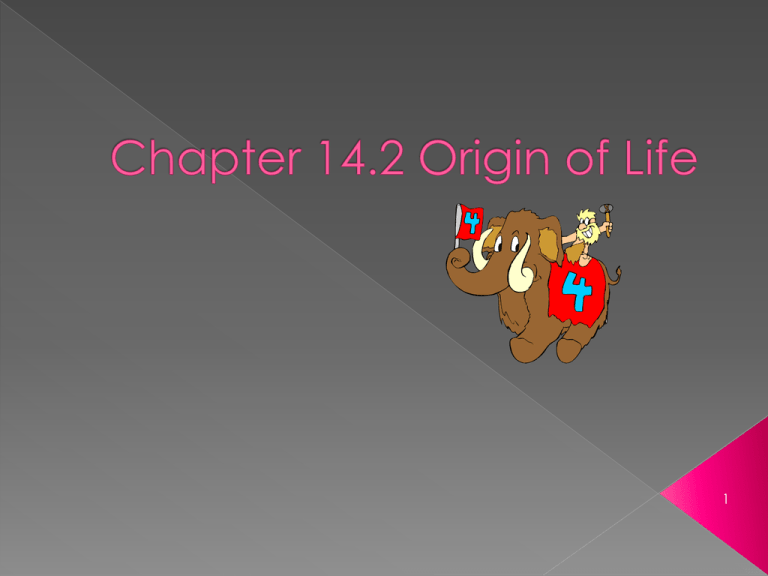
1 Principle that all living things come from other living things. Before the 17th century (1600s), another idea was widely accepted. Spontaneous generation › The idea that living things could arise (come from) nonliving things. i.e., maggots appeared on rotting meat; fish appeared in ponds that had been dry the previous season – people thought the mud gave rise or life to the fish. 2 Italian scientist noticed, described different developmental forms of flies. › Wormlike maggots – sturdy oval cases. › Flies emerged from cases. › Observed that maggots always appeared where adult flies had previously landed. Caused him to question spontaneous generation from rotting meat. 3 Redi’s experiment conducted in 1668 to test his hypothesis. › Meat kept away from adult flies would remain free of maggots. He performed a controlled experiment. Experimental Group › Jars contained meat – covered with nets Control Group › Uncovered jars which also contained meat 4 In the experimental group › The netting allowed air to enter, yet prevented the adult flies from landing on the meat. After a few days › Maggots swarmed over the meat in the uncovered jars. › The net covered jars remained free of maggots. Redi’s experiment showed flies come only from eggs laid by other flies. Redi’s hypothesis was confirmed. Major strike against the hypothesis of spontaneous generation. 5 A new tool enters the picture about the same time that Redi was performing his experiments. Microscope New revelation › World teeming with tiny creatures Discovered › microorganisms are simple in structure › amazingly numerous and widespread Microorganisms believed to arise from a “vital force” in the air. 6 Italian scientist designed an experiment to test hypothesis of spontaneous generation of microorganisms. Knew that microorganisms grew easily in food. Tested their growth in meat broth. 7 Boiled meat broth This was to kill all microorganisms already present in the broth, on the glass of the flask and in the air within the flask. Experimental Group › Boiled clear, fresh broth in a straight neck flask until flask filled with steam. › Sealed the flasks by melting their glass necks closed while the broth was hot. 8 Control Group › Flasks were left open Results › Broth in the experimental group remained clear, free of microorganisms. › Broth in the control group became cloudy › Contamination with microorganisms Spallanzani’s Conclusion › Boiled broth contaminated when microorganisms in the air entered the flask. 9 Opponents objected to his method. They disagreed with his conclusions. Said he had heated the flasks too long This destroyed the “vital force” in the air inside the flasks. Because of this, no microorganisms would form in the broth. Because of opposition, spontaneous generation was kept alive for another century. 10 Spontaneous generation controversy grew intense by the mid-1800s. Paris Academy of France › Offered prize to anyone who could solve this dilemma. › The winner was Louis Pasteur. 11 Pasteur expanded on Spallanzani’s experiment. Instead of using a straight-neck flask, he made a curved-neck flask. › This allowed air inside the flask to mix with the air outside the flask. The curve in the neck of the flask › prevented solid particles, such as microorganisms, from entering the body of the flask. 12 Experimental Group › Curved-neck flasks › Broth remained clear up to a year Pasteur broke off the curved necks Broth became cloudy & contaminated with microorganisms in a day. Pasteur’s Conclusion › In comparing his experimental group to Spallanzani’s control group, Pasteur reasoned that the contamination was caused by microorganisms in the air. 13 Those who believed in spontaneous generation conceded and gave up their fight. The principle of biogenesis became a cornerstone of biology. 14
